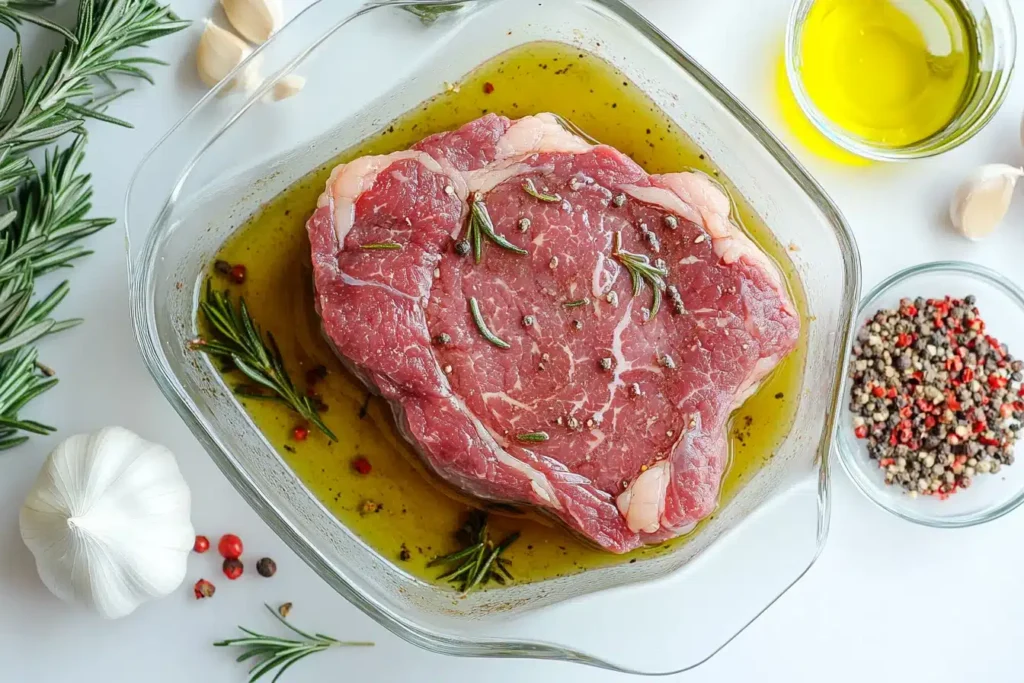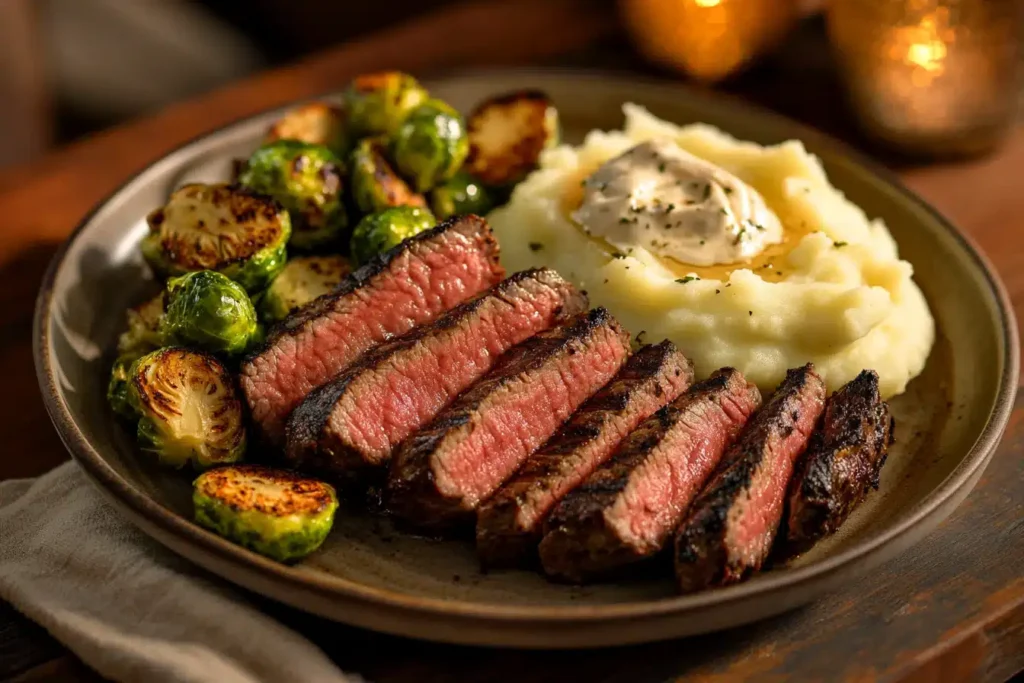When it comes to affordable yet flavorful cuts of beef, few rival the versatility of chuck steak. How is chuck steak best cooked? The answer depends on the method you choose—whether grilling, slow-cooking, or pan-searing. While often overshadowed by premium cuts like ribeye or filet mignon, chuck steak has a charm of its own when prepared correctly. This guide will walk you through everything you need to know, from marination tips to the best cooking techniques, ensuring your steak turns out tender, juicy, and packed with flavor.
Understanding Chuck Steak
What is Chuck Steak?
Chuck steak is a cut of beef that comes from the shoulder and neck region of the cow. Known for its rich, beefy flavor, it’s a popular choice for recipes that involve slow cooking or grilling. Unlike pricier cuts such as ribeye, chuck steak contains more connective tissue, which can make it tough if cooked improperly. However, when prepared the right way, it transforms into a melt-in-your-mouth delight.
This cut has earned a reputation as the “working man’s steak” due to its affordability. But don’t be fooled by the price tag—chuck steak packs a punch when it comes to flavor, making it an excellent choice for everyday meals.
Why Choose Chuck Steak?
Why opt for chuck steak over more expensive cuts? The answer lies in its versatility and flavor. It’s not just about saving money—this cut is packed with marbling, which adds a depth of flavor when cooked properly. Plus, its robust texture makes it perfect for absorbing marinades and seasonings, enhancing its taste even further.
Chuck steak is also a nutritional powerhouse, offering a high protein content along with essential vitamins and minerals. Whether you’re grilling it to perfection or slow-cooking it with vegetables, this cut can easily become a family favorite.
Preparing Chuck Steak for Cooking
The Importance of Marination
Marination is the key to unlocking the full potential of chuck steak. This process not only adds flavor but also tenderizes the meat, breaking down its tougher fibers. The best marinades for chuck steak combine acidic components like vinegar or citrus juice with olive oil and a medley of seasonings such as garlic, rosemary, and red pepper flakes.
For instance, a classic Italian marinade with red wine vinegar and garlic can transform chuck steak into a melt-in-your-mouth masterpiece. The longer you marinate—ideally 24 hours—the better the results. Don’t skimp on this step, as marination ensures your steak will be flavorful and tender, even if you’re cooking it quickly.

Room Temperature and Seasoning
Before cooking, it’s essential to bring chuck steak to room temperature. Letting it rest outside the refrigerator for 20–30 minutes allows for even cooking and prevents the meat from seizing up when it hits high heat.
When it comes to seasoning, simplicity is often best. A mixture of salt, black pepper, and garlic powder is a tried-and-true combination. For an extra kick, add some crushed red pepper flakes or smoked paprika. If you’re short on time, a pre-made dry rub can work wonders too. Seasoning should be applied generously to ensure that every bite bursts with flavor.
Cooking Methods for Chuck Steak
Grilling Chuck Steak
Grilling is one of the most popular ways to cook chuck steak. Start by preheating your grill to medium-high heat. Remove the steak from the marinade, pat it dry, and place it on the hot grill. Cook each side for 3–4 minutes for a good sear, then move the steak to indirect heat to finish cooking. Use a meat thermometer to ensure the internal temperature reaches your desired doneness—145°F for medium-rare.
Adding a dollop of garlic butter while the steak rests will elevate its flavor. Serve with grilled vegetables or a baked potato for a complete meal.
Pan-Seared Chuck Steak
For those without a grill, pan-searing is an excellent option. Use a cast-iron skillet for best results. Heat the skillet until it’s smoking hot, then add a pat of butter or oil. Place the chuck steak in the pan and sear each side for 3–4 minutes. Lower the heat and let the steak cook through, covered, for another 5–7 minutes.
Pan-seared chuck steak pairs beautifully with a side of mashed potatoes or sautéed greens.
Slow Cooking or Braising
Braising is a go-to method for achieving tender, juicy chuck steak. Start by searing the steak in a hot pan, then transfer it to a slow cooker. Add liquid—beef broth, red wine, or a mixture of both—along with aromatics like onions, carrots, and celery. Cook on low for 6–8 hours or until the meat is fork-tender.
This method is perfect for hearty meals and can be paired with creamy polenta or crusty bread.
Oven-Baked Chuck Steak
Oven-baking is another option for cooking chuck steak. Preheat your oven to 350°F and sear the steak in a skillet before transferring it to a baking dish. Cover the steak with foil and bake for 20–30 minutes, checking occasionally to avoid overcooking.
For added flavor, consider topping the steak with caramelized onions or mushrooms before baking.
For more ideas on crafting marinades that enhance flavor, check out this Chicken Fajita Marinade Guide, which shares tips applicable to other meats like chuck steak.
Enhancing Chuck Steak Flavor
Using Compound Butter
If you’ve ever wondered, How is chuck steak best cooked for maximum flavor? The answer often lies in the finishing touches. Compound butter is one of the easiest ways to elevate your chuck steak. By blending softened butter with garlic, fresh herbs like rosemary or thyme, and a pinch of salt, you can create a rich, flavorful topping.
To use, slice a small pat of the compound butter and place it on the steak immediately after cooking. The heat from the steak will melt the butter, infusing it with aromatic flavors. Whether you’re grilling, pan-searing, or baking, compound butter guarantees a steakhouse-quality meal.
Pairing Chuck Steak with Side Dishes
The right side dish can make or break your meal. Since chuck steak has a robust, beefy flavor, it pairs well with creamy or savory sides. Classic mashed potatoes, roasted Brussels sprouts, or even a tangy coleslaw are excellent choices.
For a lighter option, try a fresh green salad with a balsamic vinaigrette. The acidity balances the richness of the steak. If you want to get creative, consider serving your chuck steak with a sweet potato gratin or garlic parmesan asparagus. These pairings transform your meal into a dining experience.

For more meal inspiration, explore other recipes, such as Chicken Apple Sausage Recipes, which offer innovative ideas for side dishes.
Common Mistakes to Avoid
Overcooking the Steak
One of the biggest pitfalls in cooking chuck steak is overcooking. Unlike tender cuts, chuck steak can become tough if exposed to high heat for too long. To avoid this, always use a meat thermometer to monitor the internal temperature. Aim for 145°F for medium-rare or 160°F for medium.
Another tip? Let the steak rest for a few minutes after cooking. This step allows the juices to redistribute, keeping your steak moist and flavorful.
Skipping the Resting Period
Speaking of resting, skipping this step is a rookie mistake. When you cut into a steak immediately after cooking, the juices spill out, leaving the meat dry. Resting ensures every bite is tender and juicy. A good rule of thumb is to rest the steak for about 5 minutes for every inch of thickness.
For more cooking tips that guarantee success in the kitchen, check out our other steak-centric articles and guides!
Recipes and Variations
Chuck Steak Marinade Recipe
A good marinade is essential for making the best chuck steak. Here’s a quick recipe:
- 4 tablespoons olive oil
- 2 tablespoons red wine vinegar
- 2 cloves minced garlic
- 1 teaspoon Italian seasoning
- 1 teaspoon brown sugar
- Salt and pepper to taste
Mix the ingredients in a bowl, then coat the steak thoroughly. Refrigerate for at least 4 hours, or preferably overnight. This marinade will bring out the steak’s rich flavors while tenderizing it for grilling or pan-searing.
Popular Chuck Steak Recipes
- Grilled Chuck Steak: Marinate the steak, then grill it over medium-high heat for 4–6 minutes per side. Add a dollop of garlic butter for extra flavor.
- Braised Chuck Steak with Vegetables: Sear the steak, then slow-cook it in beef broth with carrots and potatoes. Cook on low for 6–8 hours for a hearty meal.
- Pan-Seared Chuck Steak: Use a cast-iron skillet to sear the steak on high heat, then lower the heat and cook to your desired doneness. Serve with mashed potatoes or steamed greens.
These recipes showcase the versatility of chuck steak, proving it can shine in any kitchen!
Additional Resources and Related Recipes
Recommended Reads and Recipes
For more culinary inspiration, consider exploring related recipes. Discover innovative ways to use marinades and seasonings with the Chicken Fajita Marinade Guide. This guide can help you apply similar techniques to chuck steak and other cuts of beef.
Additionally, check out Beef Chuck Eye Steak Guide for insights into preparing its equally flavorful counterpart. These resources are packed with practical tips and creative ideas to expand your cooking repertoire.
Final Words
Cooking chuck steak may seem daunting at first, but it’s all about patience and technique. Whether you’re feeding a family or hosting a dinner party, this flavorful cut is sure to impress. With these tips and recipes, you’ll never have to wonder again, How is chuck steak best cooked? Dive in, experiment, and enjoy every bite!
Frequently Asked Questions
What is the difference between chuck steak and chuck roast?
Both chuck steak and chuck roast come from the shoulder section of the cow, but they differ in how they’re cut. Chuck steak is a thinner slice, often around 1–2 inches thick, making it suitable for grilling or pan-searing. Chuck roast, on the other hand, is a larger, tougher cut ideal for slow-cooking methods like braising. If you’re wondering, How is chuck steak best cooked? The answer lies in choosing the right cooking method for its thickness and texture.
Is it necessary to marinate chuck steak?
Marinating chuck steak is highly recommended to enhance its flavor and tenderness. Marinades with acidic components like vinegar or lemon juice help break down the tough fibers, making the steak easier to chew. Without marination, chuck steak may not reach its full flavor potential, especially if cooked quickly. A simple blend of olive oil, garlic, and herbs works wonders.
Can chuck steak be cooked in the oven?
Absolutely! Chuck steak can be oven-baked for a hands-off approach. Start by searing it in a skillet to lock in juices, then bake at 350°F until it reaches your desired doneness. Adding a sauce or covering it with foil helps retain moisture, ensuring a juicy, tender result.
Conclusion and Final Tips
Recap of Key Tips for Cooking Chuck Steak
So, how is chuck steak best cooked? The secret lies in preparation and technique. Whether you prefer grilling, pan-searing, slow-cooking, or oven-baking, marination is your best friend. It enhances flavor and tenderizes the meat, making even this budget-friendly cut taste gourmet. Using compound butter and pairing it with the right sides further elevates the dish.
Remember to avoid common pitfalls like overcooking or skipping the resting period. These simple yet essential steps ensure your steak turns out tender and juicy every time.
Encouragement to Experiment with Techniques
Cooking chuck steak offers endless opportunities to get creative in the kitchen. From experimenting with marinades to trying new side dishes, there’s always something exciting to discover. Don’t be afraid to mix and match flavors to suit your taste. With a little practice, you’ll master the art of cooking this versatile cut like a pro.

